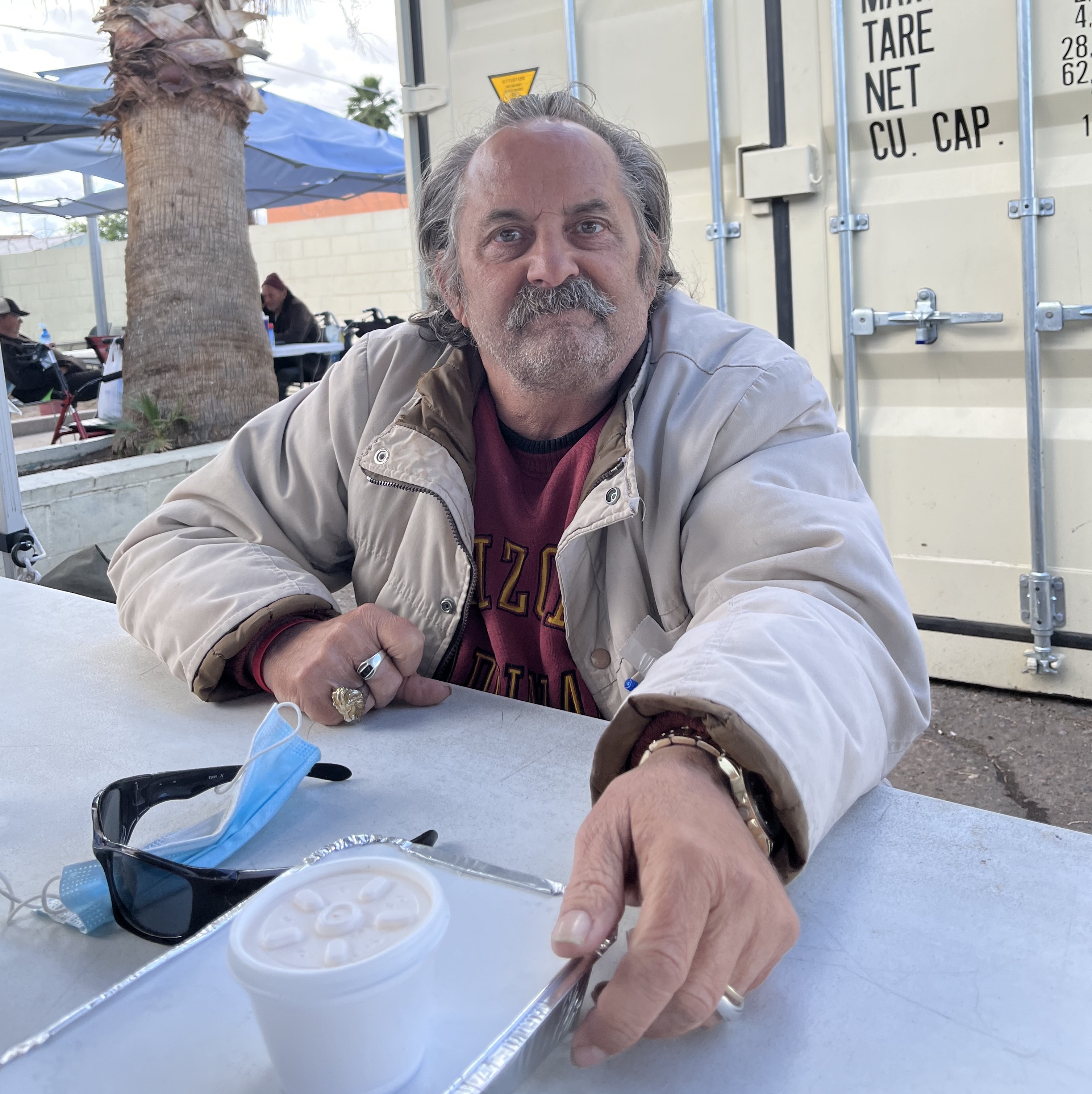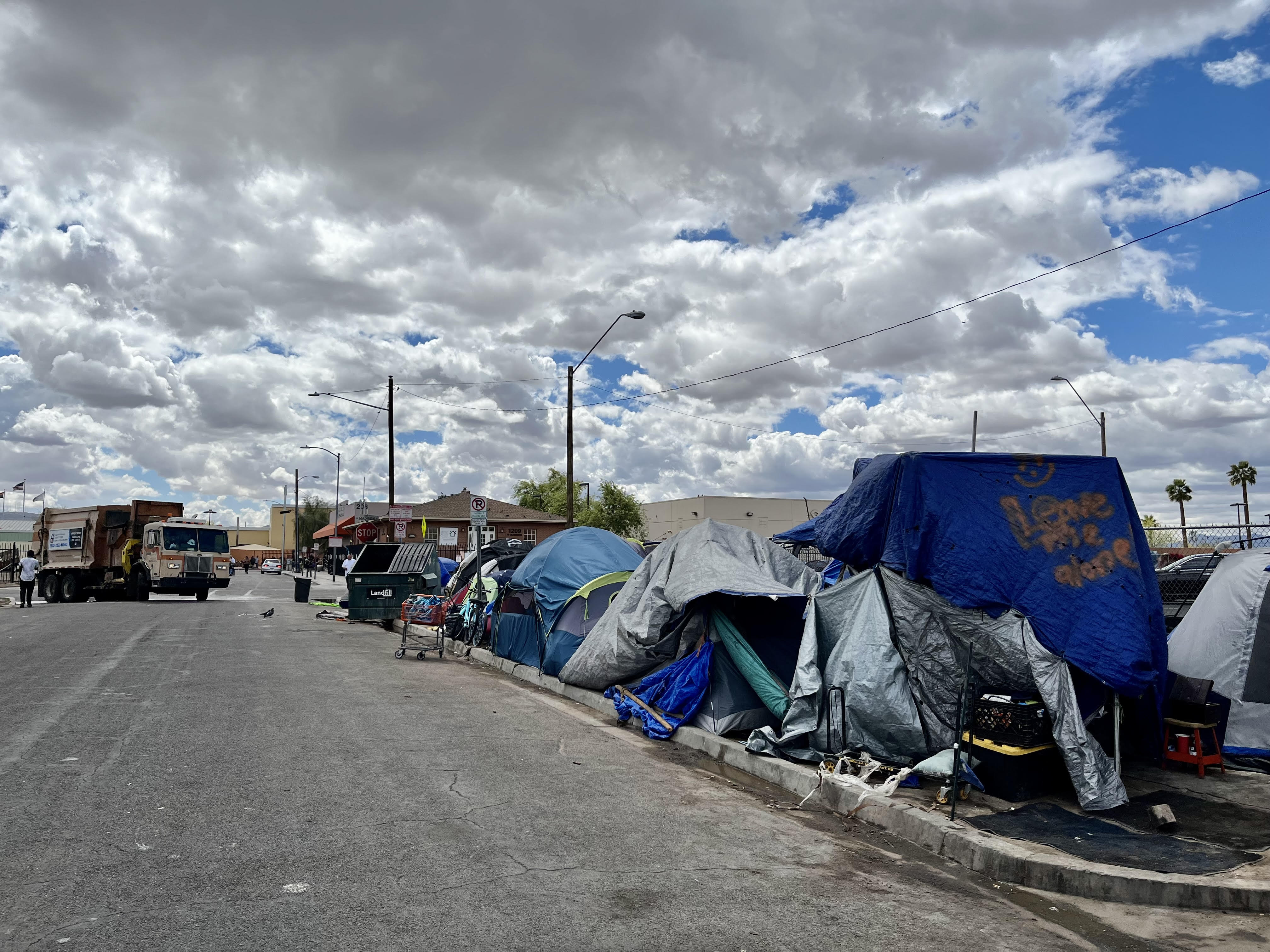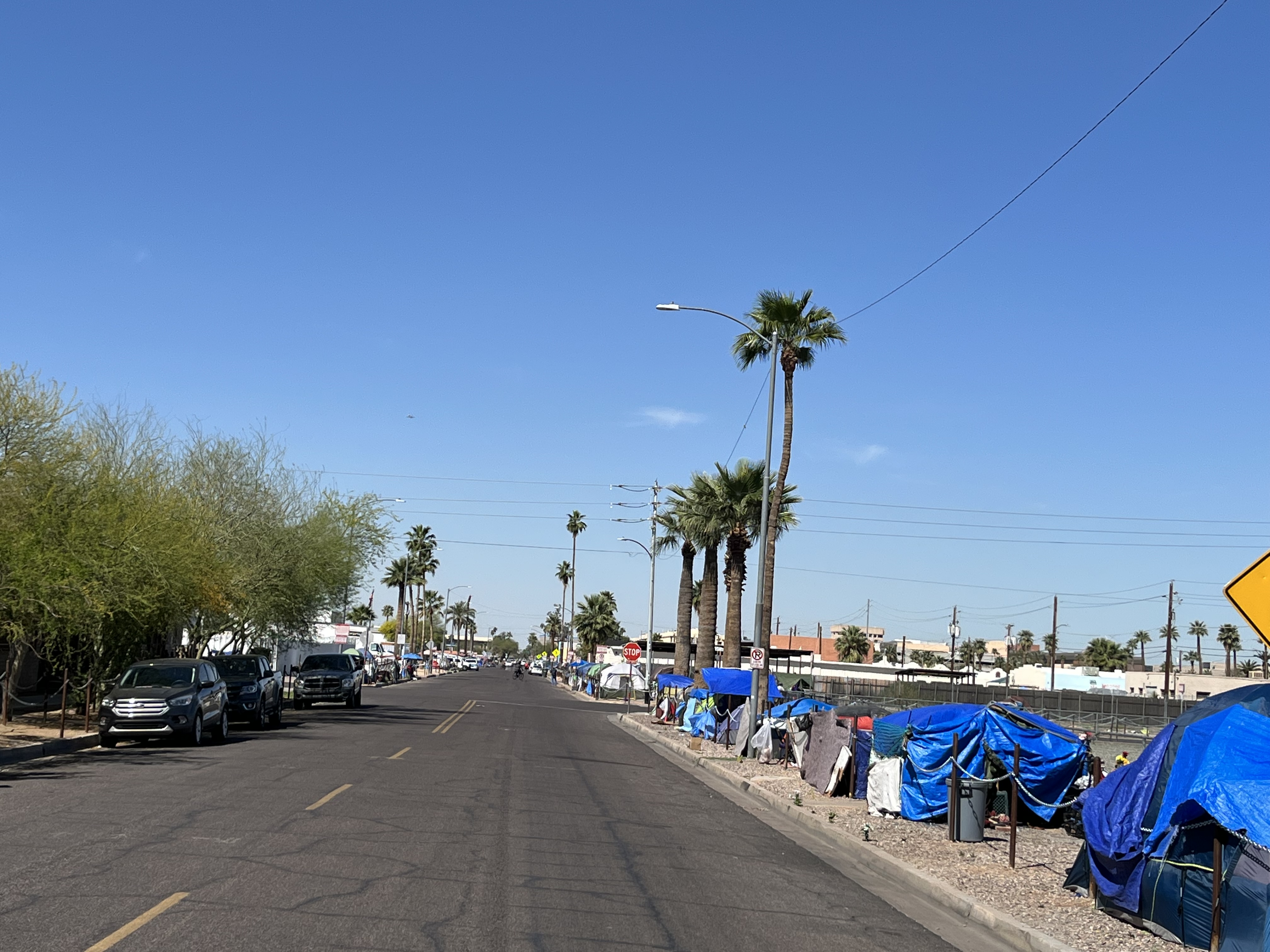Why One of America’s Largest Tent Cities Sprang Up in Phoenix
PHOENIX — After 68-year-old Steve Harrison’s landlord jacked up his rent from $970 to $1,300, he had no choice but to start sleeping in his little 2001 Toyota Echo, parked in one of the nation’s largest homeless encampments, near downtown Phoenix.
Harrison, a grandfather to 10 kids and a former school custodian, never saw himself landing here. But he only makes $1,450 a month between retirement and Social Security benefits. He couldn’t live on $150 after accounting for rent. So he was evicted from his studio apartment in February after refusing to pay—and joined what has quickly become a humanitarian crisis in Arizona’s otherwise bustling capital city.
“It’s crazy,” Harrison said while sitting in the Justa Center, which provides support to homeless seniors living in the area. “They need to regulate the rent in this town.”
Harrison had no idea how big the encampment had become until he was in it himself. Now, he sometimes sees his former neighbors out on the streets.

Over the last several months, the encampment, which spans several blocks, has swelled to some 1,000 people sleeping in or beside lines of tents, shopping carts, tarps, bikes, and dumpsters. The tent cities that make waves on the West Coast typically top out at a few hundred people. Phoenix’s is well past that—only Los Angeles’ Skid Row really rivals its size.
Many of the residents in the camp are elderly and use wheelchairs, canes, or walkers. Several people there said they’d become homeless during the pandemic, either because their rent prices soared or because they lost the ability to pay rent when they couldn’t get work. The surging rents are especially untenable for people like Harrison, who lives on a fixed income, like many others in the camp.
Though many residents of the camp spoke about fears of drug use, fires, and violence there—a 19-year-old fatally stabbed another person nearby ust last week, reportedly over a dispute about money and shoes—they also acknowledged there was nowhere else to go.
“It’s depressing, and it’s tragic, and it’s horrifying,” said Amy Schwabenlender, the director of the Human Services Campus, a 13-acre hub with a slate of resources for homeless people just outside of the encampment. She can see the crammed-together tents from her office window. “The lack of urgency that decision-makers and people with money seem to have about addressing it is incredibly sad and frustrating.”
Hundreds more people sleep inside a large Central Arizona Shelter Services facility on the campus, as well as in an additional COVID relief shelter. The shelter can house 520 adults, but it’s typically full. When beds do become available indoors, though, some homeless people said they still opt to stay outside due to conditions in the shelter. Altogether, nearly 2,000 homeless people live in the immediate area, either in the encampment or on the Human Services Campus, according to Schwabenlender.
“With the pandemic, it destroyed everybody.”
Even in a topsy-turvy pandemic housing market where renters wage bidding wars and homebuyers compete with out-of-state investors, Phoenix’s growth manages to stand out. The typical home value in the Phoenix-Mesa-Scottsdale area grew by about $103,500 between December 2020 and December 2021. That’s about twice the region’s median annual income, according to Zillow. Rent prices in Phoenix have also surged about $377 on average, or about 25 percent, since last February, compared to a national increase of $274, data from Zillow shows.
Unsurprisingly, some households just can’t handle that kind of increase: About a quarter of Americans lack any emergency savings, and inflation, which is at its highest point in decades nationwide, is hitting Phoenix particularly hard. And some families are still reeling from the widespread job loss triggered by COVID-19, plus the end of the special government benefits and stimulus checks meant to cushion the blow.
“With the pandemic, it destroyed everybody,” Mike Andrews, a gregarious 64-year-old in a button-down shirt, said from inside his tent as he shared drinks and snacks with friends. “There’s a thin line between you and normal life, between you and that guy standing in front of a Circle K asking you for 25 cents.”
Andrews, who said he lost his political fundraising job due to the pandemic, is on a waiting list for housing. One of Andrews’ friends at the camp, a 59-year-old man who declined to give his full name, also became homeless for the first time during the pandemic. He sleeps inside the shelter.
“I’ve met every walk of life here,” Andrews said.
‘Everything is going up’
At around 4 a.m. Wednesday, volunteers and employees at the Human Services Campus fanned out across the dark encampment, where many residents were still sleeping, to try to get a better grip on how people got here and how they could get help. Even at that early hour, a couple of people were already leaving to get to their jobs.
Some of the participants were part of an effort to count unhoused people across Maricopa County just a few months back. At the time, the data showed the unsheltered homeless population had increased by 35 percent since the start of the pandemic, with about 5,000 people sleeping outside in the entire county.
Since then, the situation at the encampment near downtown has somehow gotten even worse. A week before the county-wide count took place in January, 728 people were sleeping outside the Human Services Campus, according to Schwabenlender. By March 1, it was 948 people.
“A lot of clients have jobs and just can’t get an apartment,” said Alexa Parra, an outreach navigator at Community Bridges, an organization that provides a host of services for homeless people on the Human Services Campus. “Everything is going up.”
As Parra and others walked through a section of the encampment, gently approaching tents and offering free cigarettes, they asked people a bevy of questions: their name, age, ethnicity, race, gender, veteran status, whether they had an ID to get on campus and access services, and what kind of help they might need, among others. Some of the people conducting the survey put on face masks, not due to COVID-19 but because of the smell of urine emanating from the streets.

A 35-year-old resident of the nearby homeless shelter, Marie-Claire—“like the magazine”—said that she, too, became homeless last year. Her landlord didn’t renew her lease in Mesa after she complained that a neighbor had been sexually harassing her.
While she receives disability payments, landlords typically want a gross income three times the actual rent price. That made it almost impossible for her to sign a lease, despite the fact that she has money to foot the bill.
“When I do find an apartment, they are booked, booked, booked,” Marie-Claire said. “Oh my gosh, I can’t believe how many apartments I’ve seen. I’m on five waiting lists.”
Zach West, a 32-year-old homeless man living in a tent in the encampment, said he lost his restaurant job when the pandemic hit, though he received unemployment for a while. But then his landlord raised the rent on his one-bedroom apartment from $750 to $1,250 after minor renovations, and he was evicted.
Eventually, he wound up at the encampment with his boyfriend. West said he’s been on a housing waiting list for years, though he’s hoping he’ll be able to get a place through a federal program that assists low-income people living with HIV/AIDS.
“There’s new people every day,” West said. “When I first moved to Phoenix, I had a beautiful three-bedroom house in the most desirable neighborhood in the city for $850 a month. That house now rents for $1,500—almost doubled in rent.”
In some ways, Phoenix has become a victim of its own success. Coming out of the recession, the city started to experience a massive population boom, which coincided with institutional investors swooping in to purchase a bunch of cheap homes to rent, according to Mark Stapp, a professor of real estate at Arizona State University’s W.P. Carey School of Business. Phoenix at one point had grossly overbuilt, leaving an excess supply of real estate. Then the city’s economy expanded at a breakneck pace; it eventually started to run out of lots to build homes on.
Work-from-anywhere policies during the pandemic also meant that people with droll office jobs in overpriced cities could look to sunny Phoenix for a change of pace. Between 2020 and 2021, Maricopa County gained more residents from domestic migration than anywhere else in the U.S., according to census data.
“There’s winners and losers in this economic expansion,” Stapp said. “You talk to the economic development people, you talk to the elected officials, they’re excited because we’ve got substantial amounts of really good job growth. We’re a very attractive market in that regard.”
Yet the low-income workers who might’ve been able to afford a modest apartment before the pandemic now have to contend with higher rent prices without the kind of wages they'd need to match them. And the people who were barely holding on pre-pandemic are getting pushed out entirely.
“We have an increasing number of working poor, and they’re very vulnerable,” Stapp said. “It takes one thing—flat tire, transmission, you catch COVID, you’re out of work, something happens—and before you know it, you’re so vulnerable, you’re homeless. We saw that happening in places like San Francisco. It’s happening here.”
Yes, some people at the encampment choose to be there, homeless service workers acknowledged. Drug use is rampant. Mental illness is profound. But sometimes it’s the actual act of living outside that breaks people down.

There are efforts to get people back indoors, or at least into more tenable conditions. A sprung structure—the kind of quickly-constructed building that’s used in the military or for an emergency field hospital—will offer 100 new beds on campus, as well as additional restrooms. Lisa Glow, the chief executive officer of Central Arizona Shelter Services, said her facility plans to add 80 beds by June.
On the state level, a bill would put $50 million toward structured campsites, tiny homes, and street outreach. But that legislation is backed by the Cicero Institute, a think tank out of Texas that’s pushed controversial proposals that essentially criminalize homelessness in other states. Some advocates have also been critical of the bill’s intentions, particularly since it doesn’t feature permanent housing solutions.
The cost of doing nothing, however, is even higher. A banner near Glow’s office features the names of the hundreds of homeless people who died in Maricopa County last year—Jose A., Horace F., Lynne H.
Soon, the daily temperature in Phoenix will reach highs of 90 or 100 degrees. Then what?
“With the rise in homelessness, and first-time homelessness, we’re not going in the right direction,” Glow said.
Want the best of VICE News straight to your inbox? Sign up here.
#DmtDailyNews
via https://www.DMT.NEWS
Emma Ockerman, Khareem Sudlow
